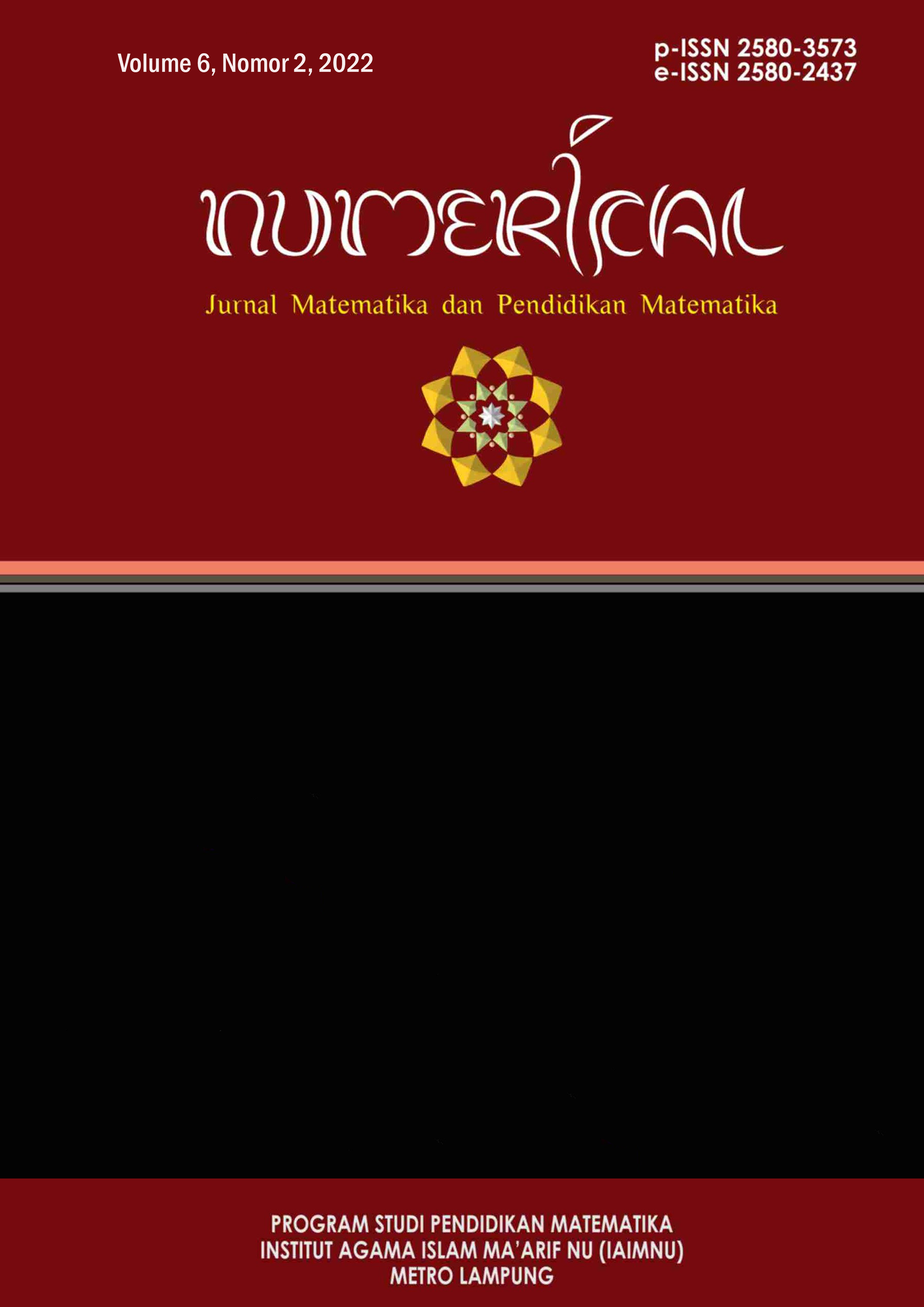Analisys of Students Mathematical Communication in Solving Pythagorean Theorem Problems Based on Level of Ability
DOI:
https://doi.org/10.25217/numerical.v6i2.3856Keywords:
Communication, Mathematics, Pythagoras, ScaffoldingAbstract
Mathematical communication ability refers to a person's ability to describe, explain, and argue in a mathematical context. Factors that cause low mathematical communication skills can vary, such as a lack of understanding of mathematical concepts, reluctance to participate in group discussions or lack of experience in communicating effective mathematics. One of the factors that can be used in overcoming the low ability of mathematical communication is by providing scaffolding. Qualitative is the approach used in this research. The subjects of this research were class VIII students of junior high school. Descriptive questions and semi-structured interviews served as research tools. The results of this study indicate that mathematical communication skills in the Pythagorean theorem have three levels with different scaffolding.
References
NCTM. (2000). Principles and standards for school mathematics. National Council of Teachers of Mathematics.
National Research Council. (2012). Education for Life and Work: Developing Transferable Knowledge and Skills in the 21st Century. Washington, DC: The National Academies Press.
Silver, E. A., & Smith, M. S. (2004). "Solving mathematics problems: A quality of learning approach." Educational Studies in Mathematics, 55(2-3), 165-194.
Ruiz-Harrison, A., & Wilkie, K. (2013). "Assessing mathematical communication and reasoning through group problem solving." School Science and Mathematics, 113(7), 342-352.
Dörfler, W., & Wachsmuth, I. (2019). "Communicative competencies in mathematics education." In M. L. Niess, & D. L. English (Eds.), Handbook of Research on Communicating and Collaborating Online in K-12 Education (pp. 385-405). Hershey, PA: IGI Global.
Boaler, J. (2002). "Learning from teaching: Exploring the relationship between reform curriculum and equity." Journal for Research in Mathematics Education, 33(4), 239-258
Wood, D., Bruner, J. S., & Ross, G. (1976). The role of tutoring in problem solving. Journal of Child Psychology and Psychiatry, 17(2), 89-100.
Cazden, C. B. (1988). Classroom discourse: The language of teaching and learning. Heinemann.
Mercer, N. (1995). The guided construction of knowledge: Talk amongst teachers and learners. Multilingual Matters.
Van de Walle, J. A., Karp, K. S., & Bay-Williams, J. M. (2012). Elementary and middle school mathematics: Teaching developmentally. Pearson.
Yackel, E., & Cobb, P. (1996). Sociomathematical norms, argumentation, and autonomy in mathematics. Journal for Research in Mathematics Education, 27(4), 458-477.
Stein, M. K., Smith, M. S., Henningsen, M. A., & Silver, E. A. (2009). Implementing standards-based mathematics instruction: A casebook for professional development. Teachers College Press.
Lampert, M. (1986). Knowing, doing, and teaching multiplication. Cognition and Instruction, 3(4), 305-342.
Creswell, John W. (2007) Qualitative Inquiry & Research Design Choosing Among Five Apporoaches. California: Sage Publication Inc.
Hendriana, H., Rohaeti, E.E., & Sumarmo, U. (2017). Hard Skills dan Soft Skills Matematik Siswa. Bandung: Refika Aditama.
Hendriana, H., Rohaeti, E.E., & Sumarmo, U. (2017). Hard Skills dan Soft Skills Matematik Siswa. Bandung: Refika Aditama.
Fitriani. D, Lubis. I.M, Kurniati A., 2021. Berdasarkan Kemadirian Belajar Siswa. Suska Journal of Mathematics Education ISSN: 2540-9670 Vol. 7, No. 1, 2021, hal. 49-58
Yuningsih, S. Kodirun. Ili L. 2020. Penerapan Teknik Scaffolding dalam Pembelajaran Matematika untuk Meningkatkan Kemampuan Komunikasi Matematis Ditinjau dari Kemandirian Belajar Siswa SMA Negeri 3 Kendari. Jurnal Pembelajaran Berpikir Matematika, Vol. 5, No.2. 145-156
Subiyakto A. Rufiana.I.S. Nurdidayah. D.A. 2020. Peningkatan Kemampuan Komunikasi Matematis Siswa Menggunakan Pembelajaran Kooperatif Tipe Two Stay Two Stray (TSTS) Berbantuan Teknik Scaffolding. Jurnal Edukasi Matematika dan Sains. 2502-4671
Hendriana, H., Rohaeti, E.E., & Sumarmo, U. (2017). Hard Skills dan Soft Skills Matematik Siswa. Bandung: Refika Aditama.
Kusuma, I. H. (2018). Faktor-Faktor yang Mempengaruhi Kemampuan Komunikasi Matematis Siswa SMP Negeri Kota Semarang. Jurnal Matematika Dan Pembelajaran, 6(2), 121-132.
"Geometry: A Comprehensive Course" oleh Dan Pedoe (1988)
Lester, F. K. (Ed.). (2013). Second handbook of research on mathematics teaching and learning: A project of the National Council of Teachers of Mathematics. IAP.
Schoenfeld, A. H. (1988). When good teaching leads to bad results: The disasters of "well-taught" mathematics courses. Educational psychologist, 23(2), 145-166.
Lannin, J. K. (2005). The Pythagorean theorem: Variation, proof, and the beauty of mathematics. Mathematics Teaching in the Middle School, 11(4), 164-169.
Hiebert, J., Carpenter, T. P., Fennema, E., Fuson, K. C., Wearne, D., Murray, H.,. Human, P. (1997). Making Sense: Teaching and Learning Mathematics with Understanding. Heinemann.
Alnar, A. (2021). Profil Pemecahan Masalah Teorema Pythagoras Ditinjau Dari Perbedaan Gaya Kognitif Pada Siswa Kelas Viii Smp Muhammadiyah 6 Makassar.
Sugiyono. (2019). Metodelogi Penelitian Kuantitatif dan Kualitatif Dan R&D. Bandung: ALFABETA.
Downloads
Published
How to Cite
Issue
Section
License
Copyright (c) 2023 Sofiatul Ilmi; Yayan Eryk Setiawan, Surya Sari Faradiba

This work is licensed under a Creative Commons Attribution-ShareAlike 4.0 International License.







